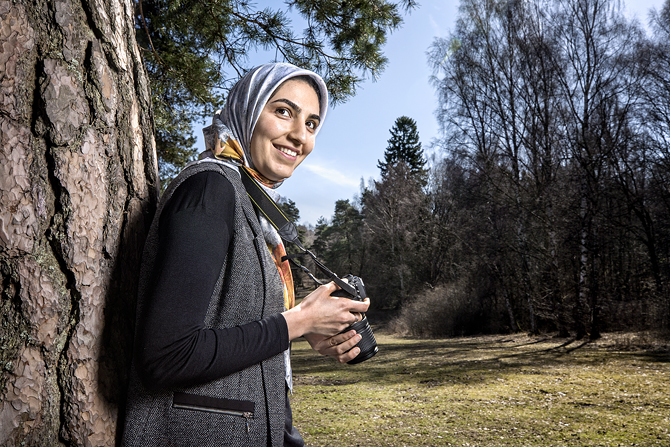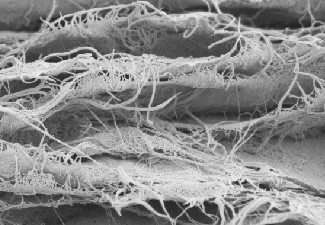Possibilities of biocomposites is Iranian researcher's focus

Trees mean a lot to doctoral student Hanieh Mianehrow. In her research at the Wallenberg Wood Science Center, she investigates new materials based on wood cellulose. In her free time, she practices her interest in photography on trees and other themes from nature.
Mianehrow lifts up a little piece of transparent film. It is a biocomposite , a renewable alternative to fossil-based plastic. Here in the lab she will look into why it works so well to blend nanofibrils of cellulose with graphene, an extremely strong, carbon-based material.
“We see that we get a strong material, but our work is about going deeper to show the mechanisms behind this,” she says.
All researchers at the Wallenberg Wood Science Center work in some way with wood.
”Some extract high quality components out of wood, some modify the components and others, like me, use them to create new composites,” Mianehrow says.
About three years ago, Mianehrow began thinking about leaving her hometown, Tehran, and searching abroad for a short time. Then she had taken her master’s degree and worked for a while in the tire and plastic industries.
”In academia, I missed projects that were not connected with industry,” she says. “But after some time in industry, I wanted to get back because I felt I wasn’t developing academically.”
One of the universities she contacted was KTH; specifically, the department for fiber and polymer technology.
“I wrote to Professor Lars Berglund , but I didn’t count on getting an answer. It was 7 p.m. on a Sunday – European time,” she says. “Twenty minutes later, I got an answer. I was welcome as a guest researcher but would stay for at least one year.”
Uncertainty about living on her own in an unfamiliar country soon vanished. After some months in Sweden, the idea of pursuing her doctorate at KTH began to form.
“From a researcher’s point of view, it felt good to stay and have new experiences. It was easy to make friends, here at KTH and at my SFI (Swedish for Immigrants) class. Also, there are a lot of Iranians here in Stockholm.”
Last year, she began her doctoral studies, which will take between four and five years. Her dissertation’s title is “Biocomposities Based on Cellulose and Platelet Reinforcements.”
When Mianehrow isn’t in the lab, there’s a good chance she is somewhere out in one of Stockholm’s parks, where she photographs trees, plants and birds with her Nikon camera. She often posts her favorites on her Instagram account (hny_0809).
Mianehrow’s mother is a nurse, who often gave her books about natural science.
”When I was 6, I had a thick book about frogs that I read every night. Another favorite was Linnea’s yearbook, which I read without knowing that it was Swedish. Maybe that’s when my love of nature began.
But Tehran is an enormous city and residents must drive long distances to reach the forest and sea. Instead, Mianehrow painted nature, including many sunsets. The interest continued until it became time to prepare for the major exam that is required for entry into university in Iran.
In high school, she focused on mathematics. After previously setting her sights on becoming a doctor, she became interested in technology. She decided instead to become an engineer.
Mianehrow graduated from Islamic Azad University, in the department of polymer technology. Writing her candidate’s statement about energy consumption of plastic forming machines raised her interest in environmental issues. She read about the European Union’s goal to reduce energy consumption by 20 percent by 2020.
”Oil is cheap in Iran, and we have a strong petroleum industry. In Europe, people worry about how nature is impacted by CO2 emissions and what should happen in the future.”
Her master’s work at Amirkabir University of Technology’s Department of Polymer Engineering and Color Technology involved a new system for delivering medicine to the body during cancer therapy. She created a carrier, based on graphene and cellulose.
”I wanted to work on a project that had more to do with natural science. In parallel, I started another project to make composites of graphene and wood pulp, and it was then that I heard about the Department of Fibre and Polymer Technology at KTH.”
What Mianehrow most appreciates about KTH is the international environment.
”One can meet people from other countries, with different ways of looking at things. In Iran, I had no friends from other religions, but here I have. We talk about everything, and my friends from, for example South America, have the same relation to their families as I have.”
She also sees good cooperation between groups and departments. Maybe the Swedish fika has something to do with that.
“There is fika for the group on Wednesdays, for the entire department on Fridays, and so fika when anyone starts here or leaves – fika all the time. It was hard to get used to at first. I thought we should work instead. But now I really like it. You work more efficiently afterward and you make a lot of contacts.”
She’s also satisfied with the courses that are included in her doctoral studies. “They are related to what I do. For example, I will greatly benefit from the course in data modeling,” she says.
During the Christmas holiday, when she returned to Tehran, “My mother said, ‘You fooled us, you said you will be there only for one year!’ But in reality both she and dad support me. My dad wants me to send photos from all parts of Sweden that I go to.”
She says the family will visit for the second time in the summer. Then they plan to travel around the country.
For her part, Mianehrow has traveled extensively in Sweden thanks to the Wallenberg Wood Science Center summer and winter schools. It’s an intitiative that enables students from the partner universities, KTH, Chalmers and Luleå Technical University to meet in different places in Sweden.
”We last visited pulp (pulp and paper manufacturer) Stora Enso in Karlstad,” she says. “And we stayed in Sunne, where we had courses and workshops.”
Future plans for the long term are an impossible question, she says.
”I was originally supposed to be here for just for one year, and now I’m staying to get my PhD. Plans change.”
Ann Patmalnieks

